Alternative Dispute Resolution Assignment
VerifiedAdded on 2020/04/29
|14
|4144
|484
AI Summary
Contribute Materials
Your contribution can guide someone’s learning journey. Share your
documents today.
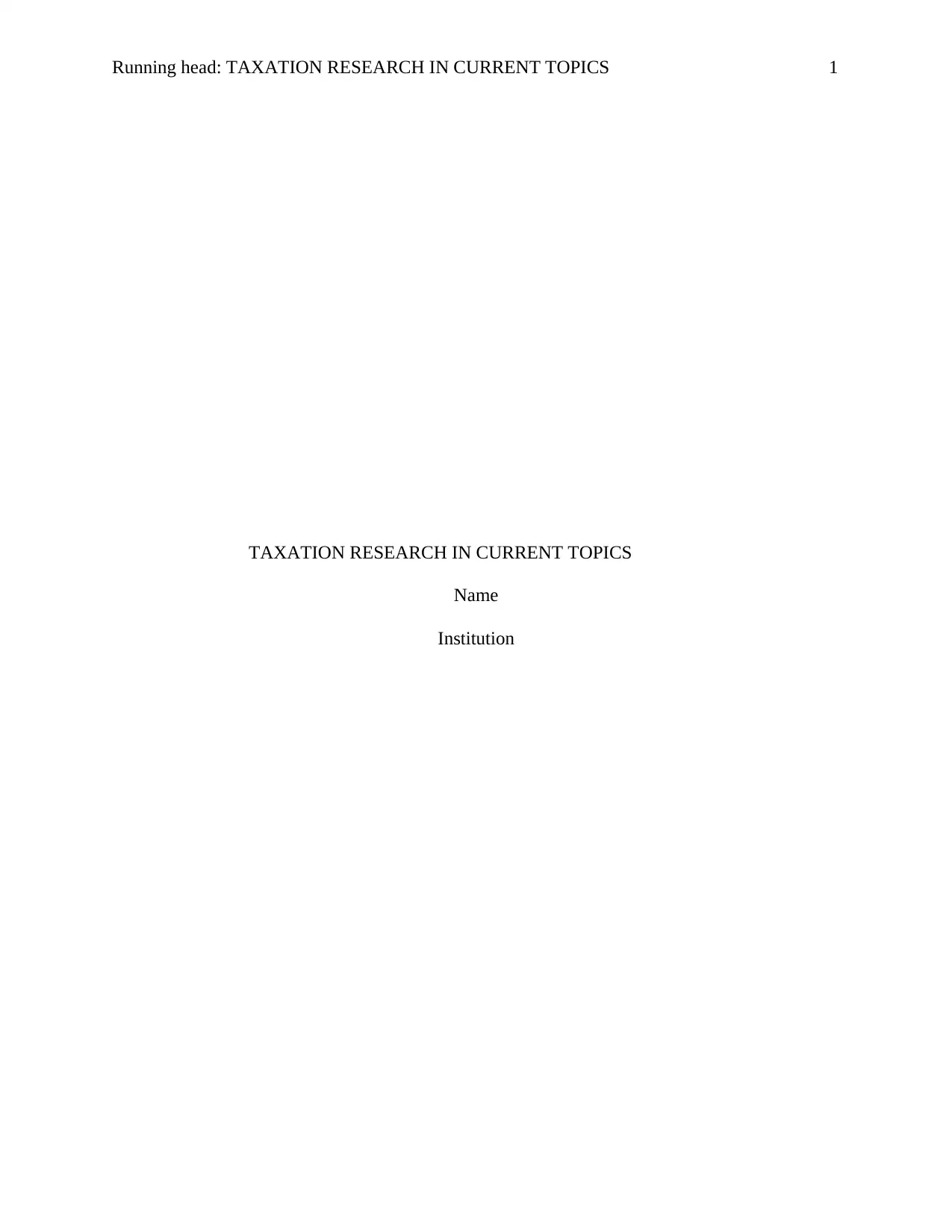
Running head: TAXATION RESEARCH IN CURRENT TOPICS 1
TAXATION RESEARCH IN CURRENT TOPICS
Name
Institution
TAXATION RESEARCH IN CURRENT TOPICS
Name
Institution
Secure Best Marks with AI Grader
Need help grading? Try our AI Grader for instant feedback on your assignments.
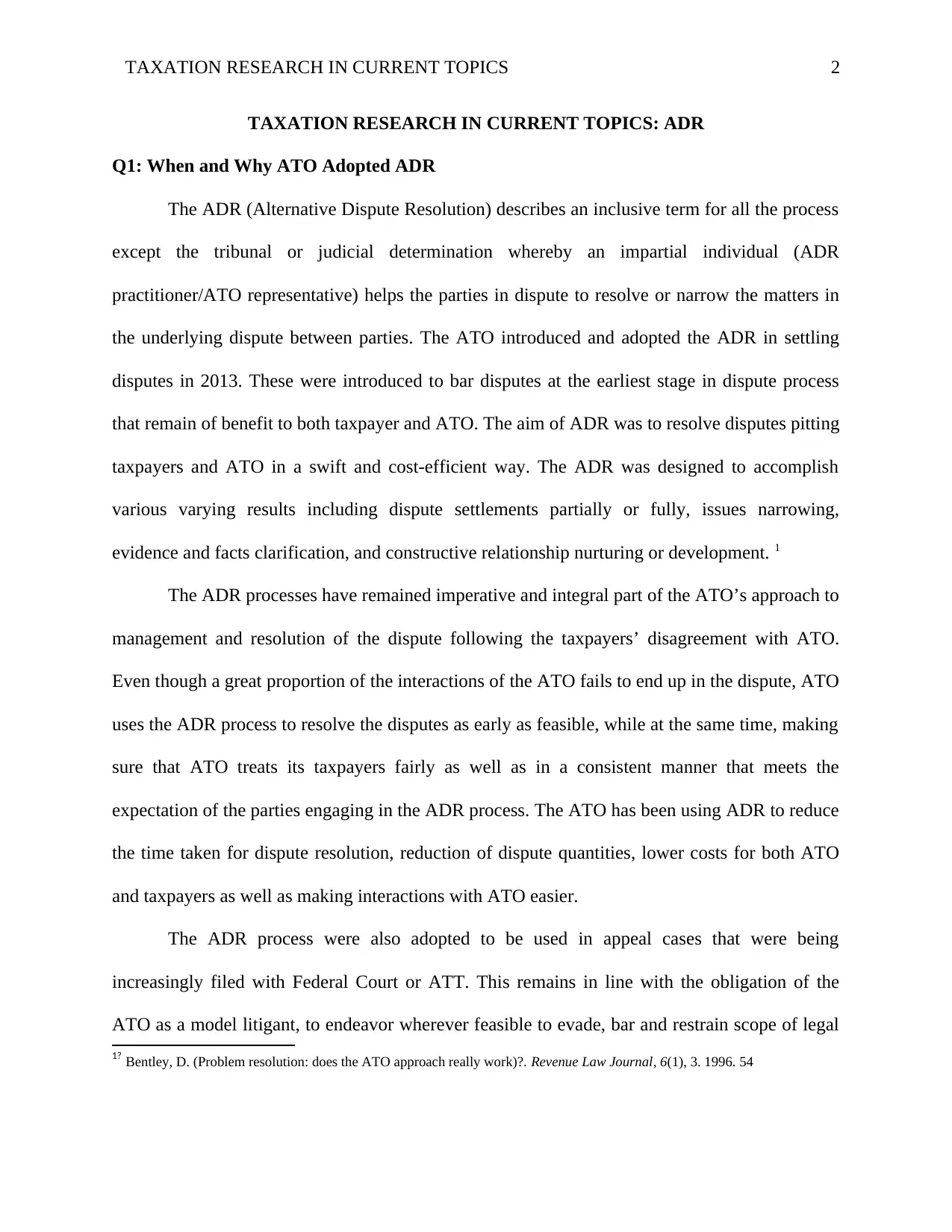
TAXATION RESEARCH IN CURRENT TOPICS 2
TAXATION RESEARCH IN CURRENT TOPICS: ADR
Q1: When and Why ATO Adopted ADR
The ADR (Alternative Dispute Resolution) describes an inclusive term for all the process
except the tribunal or judicial determination whereby an impartial individual (ADR
practitioner/ATO representative) helps the parties in dispute to resolve or narrow the matters in
the underlying dispute between parties. The ATO introduced and adopted the ADR in settling
disputes in 2013. These were introduced to bar disputes at the earliest stage in dispute process
that remain of benefit to both taxpayer and ATO. The aim of ADR was to resolve disputes pitting
taxpayers and ATO in a swift and cost-efficient way. The ADR was designed to accomplish
various varying results including dispute settlements partially or fully, issues narrowing,
evidence and facts clarification, and constructive relationship nurturing or development. 1
The ADR processes have remained imperative and integral part of the ATO’s approach to
management and resolution of the dispute following the taxpayers’ disagreement with ATO.
Even though a great proportion of the interactions of the ATO fails to end up in the dispute, ATO
uses the ADR process to resolve the disputes as early as feasible, while at the same time, making
sure that ATO treats its taxpayers fairly as well as in a consistent manner that meets the
expectation of the parties engaging in the ADR process. The ATO has been using ADR to reduce
the time taken for dispute resolution, reduction of dispute quantities, lower costs for both ATO
and taxpayers as well as making interactions with ATO easier.
The ADR process were also adopted to be used in appeal cases that were being
increasingly filed with Federal Court or ATT. This remains in line with the obligation of the
ATO as a model litigant, to endeavor wherever feasible to evade, bar and restrain scope of legal
1? Bentley, D. (Problem resolution: does the ATO approach really work)?. Revenue Law Journal, 6(1), 3. 1996. 54
TAXATION RESEARCH IN CURRENT TOPICS: ADR
Q1: When and Why ATO Adopted ADR
The ADR (Alternative Dispute Resolution) describes an inclusive term for all the process
except the tribunal or judicial determination whereby an impartial individual (ADR
practitioner/ATO representative) helps the parties in dispute to resolve or narrow the matters in
the underlying dispute between parties. The ATO introduced and adopted the ADR in settling
disputes in 2013. These were introduced to bar disputes at the earliest stage in dispute process
that remain of benefit to both taxpayer and ATO. The aim of ADR was to resolve disputes pitting
taxpayers and ATO in a swift and cost-efficient way. The ADR was designed to accomplish
various varying results including dispute settlements partially or fully, issues narrowing,
evidence and facts clarification, and constructive relationship nurturing or development. 1
The ADR processes have remained imperative and integral part of the ATO’s approach to
management and resolution of the dispute following the taxpayers’ disagreement with ATO.
Even though a great proportion of the interactions of the ATO fails to end up in the dispute, ATO
uses the ADR process to resolve the disputes as early as feasible, while at the same time, making
sure that ATO treats its taxpayers fairly as well as in a consistent manner that meets the
expectation of the parties engaging in the ADR process. The ATO has been using ADR to reduce
the time taken for dispute resolution, reduction of dispute quantities, lower costs for both ATO
and taxpayers as well as making interactions with ATO easier.
The ADR process were also adopted to be used in appeal cases that were being
increasingly filed with Federal Court or ATT. This remains in line with the obligation of the
ATO as a model litigant, to endeavor wherever feasible to evade, bar and restrain scope of legal
1? Bentley, D. (Problem resolution: does the ATO approach really work)?. Revenue Law Journal, 6(1), 3. 1996. 54
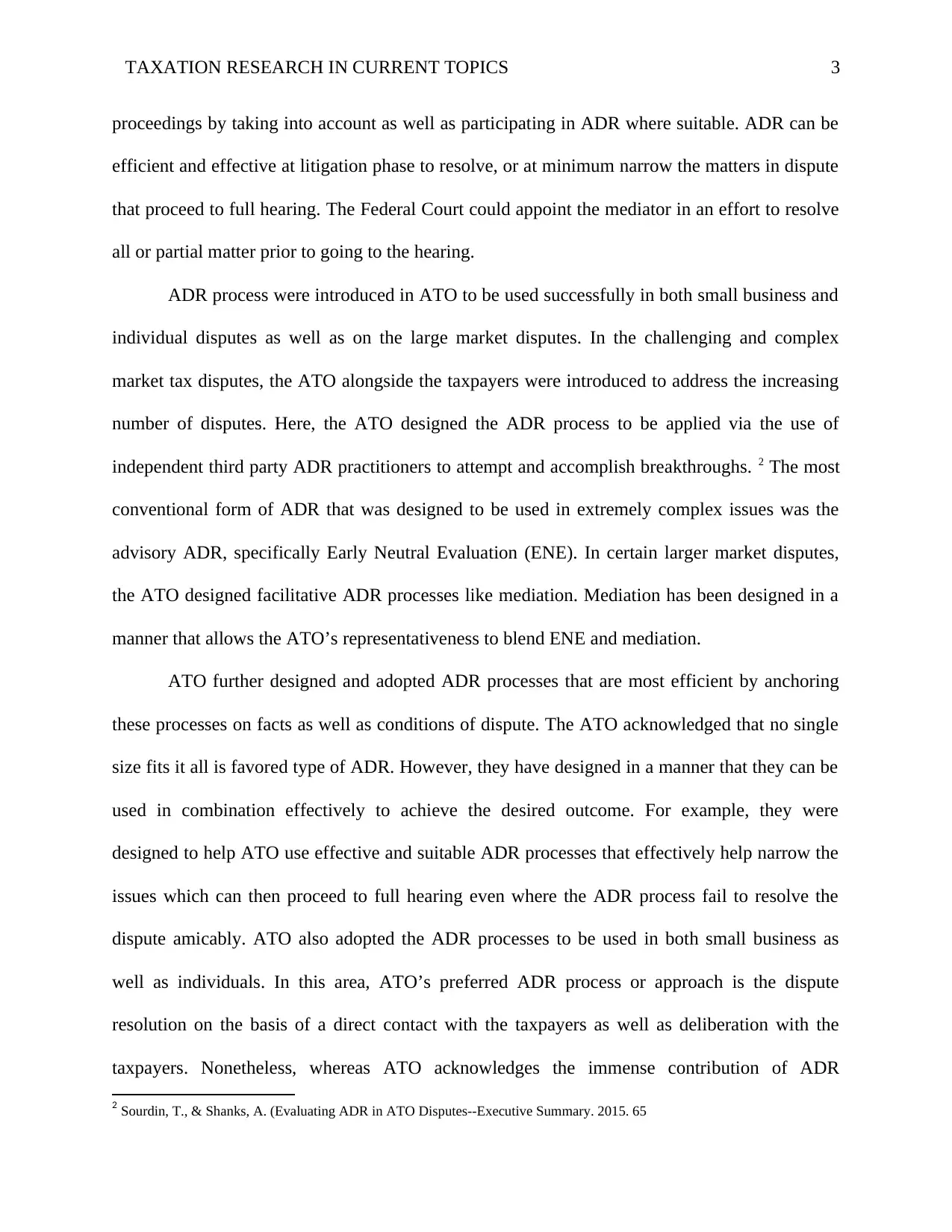
TAXATION RESEARCH IN CURRENT TOPICS 3
proceedings by taking into account as well as participating in ADR where suitable. ADR can be
efficient and effective at litigation phase to resolve, or at minimum narrow the matters in dispute
that proceed to full hearing. The Federal Court could appoint the mediator in an effort to resolve
all or partial matter prior to going to the hearing.
ADR process were introduced in ATO to be used successfully in both small business and
individual disputes as well as on the large market disputes. In the challenging and complex
market tax disputes, the ATO alongside the taxpayers were introduced to address the increasing
number of disputes. Here, the ATO designed the ADR process to be applied via the use of
independent third party ADR practitioners to attempt and accomplish breakthroughs. 2 The most
conventional form of ADR that was designed to be used in extremely complex issues was the
advisory ADR, specifically Early Neutral Evaluation (ENE). In certain larger market disputes,
the ATO designed facilitative ADR processes like mediation. Mediation has been designed in a
manner that allows the ATO’s representativeness to blend ENE and mediation.
ATO further designed and adopted ADR processes that are most efficient by anchoring
these processes on facts as well as conditions of dispute. The ATO acknowledged that no single
size fits it all is favored type of ADR. However, they have designed in a manner that they can be
used in combination effectively to achieve the desired outcome. For example, they were
designed to help ATO use effective and suitable ADR processes that effectively help narrow the
issues which can then proceed to full hearing even where the ADR process fail to resolve the
dispute amicably. ATO also adopted the ADR processes to be used in both small business as
well as individuals. In this area, ATO’s preferred ADR process or approach is the dispute
resolution on the basis of a direct contact with the taxpayers as well as deliberation with the
taxpayers. Nonetheless, whereas ATO acknowledges the immense contribution of ADR
2 Sourdin, T., & Shanks, A. (Evaluating ADR in ATO Disputes--Executive Summary. 2015. 65
proceedings by taking into account as well as participating in ADR where suitable. ADR can be
efficient and effective at litigation phase to resolve, or at minimum narrow the matters in dispute
that proceed to full hearing. The Federal Court could appoint the mediator in an effort to resolve
all or partial matter prior to going to the hearing.
ADR process were introduced in ATO to be used successfully in both small business and
individual disputes as well as on the large market disputes. In the challenging and complex
market tax disputes, the ATO alongside the taxpayers were introduced to address the increasing
number of disputes. Here, the ATO designed the ADR process to be applied via the use of
independent third party ADR practitioners to attempt and accomplish breakthroughs. 2 The most
conventional form of ADR that was designed to be used in extremely complex issues was the
advisory ADR, specifically Early Neutral Evaluation (ENE). In certain larger market disputes,
the ATO designed facilitative ADR processes like mediation. Mediation has been designed in a
manner that allows the ATO’s representativeness to blend ENE and mediation.
ATO further designed and adopted ADR processes that are most efficient by anchoring
these processes on facts as well as conditions of dispute. The ATO acknowledged that no single
size fits it all is favored type of ADR. However, they have designed in a manner that they can be
used in combination effectively to achieve the desired outcome. For example, they were
designed to help ATO use effective and suitable ADR processes that effectively help narrow the
issues which can then proceed to full hearing even where the ADR process fail to resolve the
dispute amicably. ATO also adopted the ADR processes to be used in both small business as
well as individuals. In this area, ATO’s preferred ADR process or approach is the dispute
resolution on the basis of a direct contact with the taxpayers as well as deliberation with the
taxpayers. Nonetheless, whereas ATO acknowledges the immense contribution of ADR
2 Sourdin, T., & Shanks, A. (Evaluating ADR in ATO Disputes--Executive Summary. 2015. 65
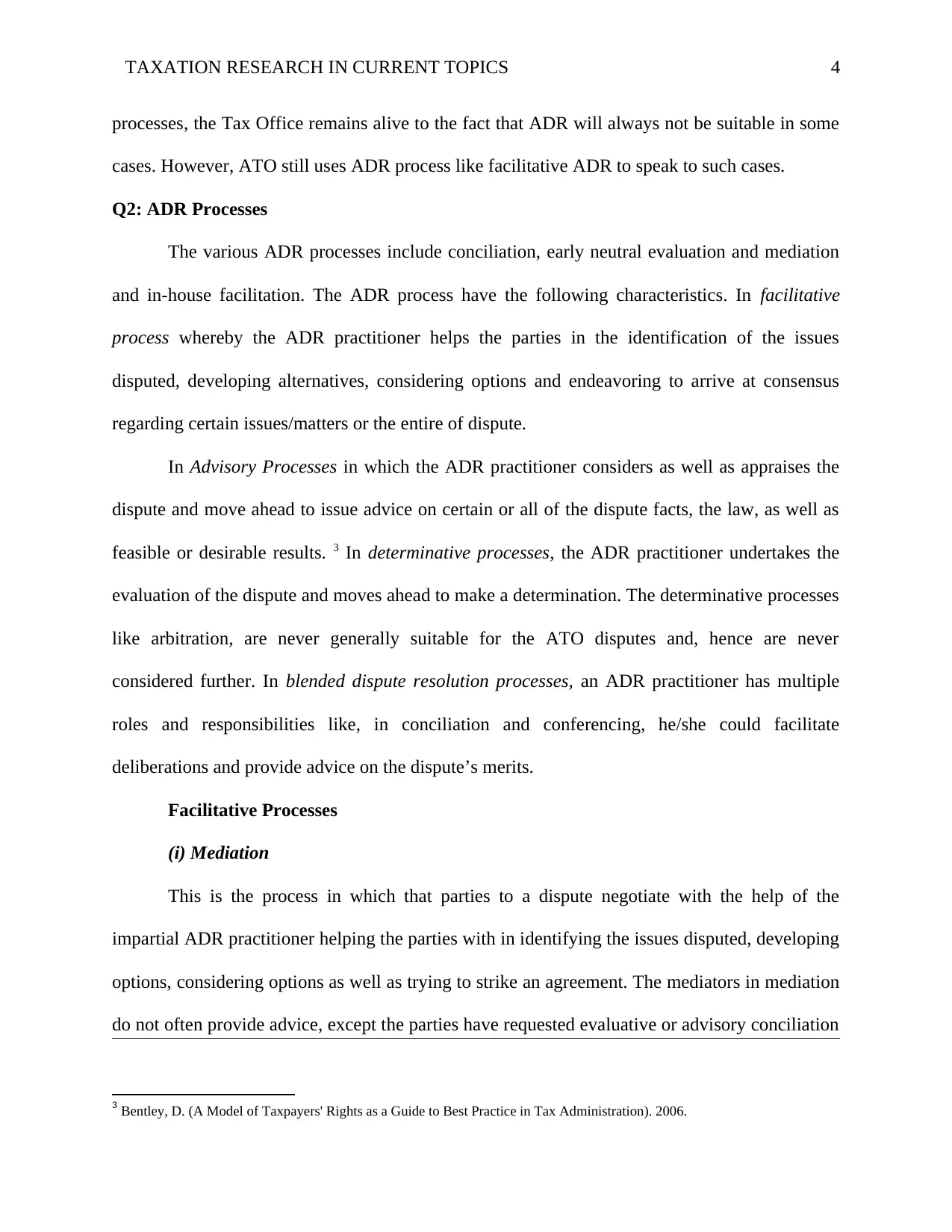
TAXATION RESEARCH IN CURRENT TOPICS 4
processes, the Tax Office remains alive to the fact that ADR will always not be suitable in some
cases. However, ATO still uses ADR process like facilitative ADR to speak to such cases.
Q2: ADR Processes
The various ADR processes include conciliation, early neutral evaluation and mediation
and in-house facilitation. The ADR process have the following characteristics. In facilitative
process whereby the ADR practitioner helps the parties in the identification of the issues
disputed, developing alternatives, considering options and endeavoring to arrive at consensus
regarding certain issues/matters or the entire of dispute.
In Advisory Processes in which the ADR practitioner considers as well as appraises the
dispute and move ahead to issue advice on certain or all of the dispute facts, the law, as well as
feasible or desirable results. 3 In determinative processes, the ADR practitioner undertakes the
evaluation of the dispute and moves ahead to make a determination. The determinative processes
like arbitration, are never generally suitable for the ATO disputes and, hence are never
considered further. In blended dispute resolution processes, an ADR practitioner has multiple
roles and responsibilities like, in conciliation and conferencing, he/she could facilitate
deliberations and provide advice on the dispute’s merits.
Facilitative Processes
(i) Mediation
This is the process in which that parties to a dispute negotiate with the help of the
impartial ADR practitioner helping the parties with in identifying the issues disputed, developing
options, considering options as well as trying to strike an agreement. The mediators in mediation
do not often provide advice, except the parties have requested evaluative or advisory conciliation
3 Bentley, D. (A Model of Taxpayers' Rights as a Guide to Best Practice in Tax Administration). 2006.
processes, the Tax Office remains alive to the fact that ADR will always not be suitable in some
cases. However, ATO still uses ADR process like facilitative ADR to speak to such cases.
Q2: ADR Processes
The various ADR processes include conciliation, early neutral evaluation and mediation
and in-house facilitation. The ADR process have the following characteristics. In facilitative
process whereby the ADR practitioner helps the parties in the identification of the issues
disputed, developing alternatives, considering options and endeavoring to arrive at consensus
regarding certain issues/matters or the entire of dispute.
In Advisory Processes in which the ADR practitioner considers as well as appraises the
dispute and move ahead to issue advice on certain or all of the dispute facts, the law, as well as
feasible or desirable results. 3 In determinative processes, the ADR practitioner undertakes the
evaluation of the dispute and moves ahead to make a determination. The determinative processes
like arbitration, are never generally suitable for the ATO disputes and, hence are never
considered further. In blended dispute resolution processes, an ADR practitioner has multiple
roles and responsibilities like, in conciliation and conferencing, he/she could facilitate
deliberations and provide advice on the dispute’s merits.
Facilitative Processes
(i) Mediation
This is the process in which that parties to a dispute negotiate with the help of the
impartial ADR practitioner helping the parties with in identifying the issues disputed, developing
options, considering options as well as trying to strike an agreement. The mediators in mediation
do not often provide advice, except the parties have requested evaluative or advisory conciliation
3 Bentley, D. (A Model of Taxpayers' Rights as a Guide to Best Practice in Tax Administration). 2006.
Secure Best Marks with AI Grader
Need help grading? Try our AI Grader for instant feedback on your assignments.
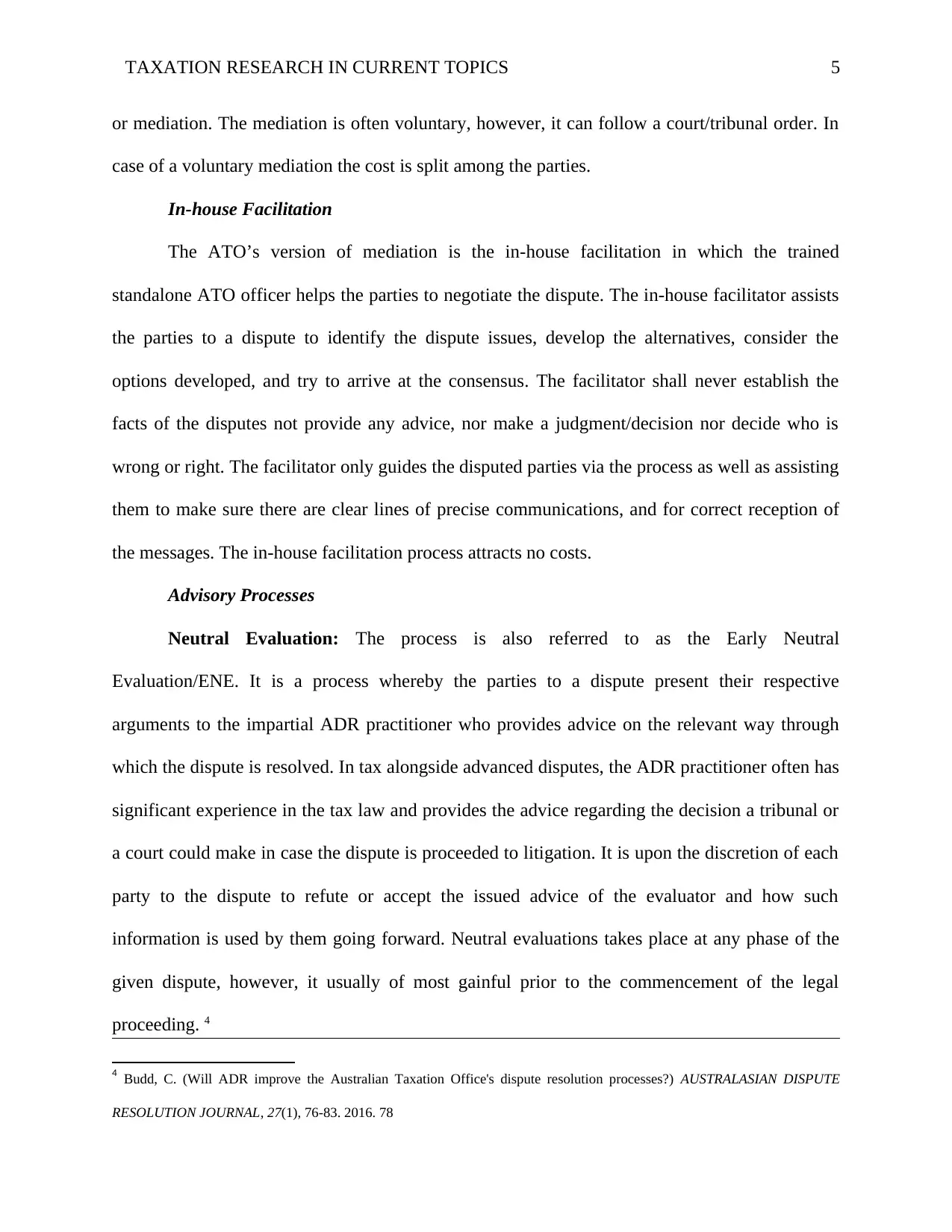
TAXATION RESEARCH IN CURRENT TOPICS 5
or mediation. The mediation is often voluntary, however, it can follow a court/tribunal order. In
case of a voluntary mediation the cost is split among the parties.
In-house Facilitation
The ATO’s version of mediation is the in-house facilitation in which the trained
standalone ATO officer helps the parties to negotiate the dispute. The in-house facilitator assists
the parties to a dispute to identify the dispute issues, develop the alternatives, consider the
options developed, and try to arrive at the consensus. The facilitator shall never establish the
facts of the disputes not provide any advice, nor make a judgment/decision nor decide who is
wrong or right. The facilitator only guides the disputed parties via the process as well as assisting
them to make sure there are clear lines of precise communications, and for correct reception of
the messages. The in-house facilitation process attracts no costs.
Advisory Processes
Neutral Evaluation: The process is also referred to as the Early Neutral
Evaluation/ENE. It is a process whereby the parties to a dispute present their respective
arguments to the impartial ADR practitioner who provides advice on the relevant way through
which the dispute is resolved. In tax alongside advanced disputes, the ADR practitioner often has
significant experience in the tax law and provides the advice regarding the decision a tribunal or
a court could make in case the dispute is proceeded to litigation. It is upon the discretion of each
party to the dispute to refute or accept the issued advice of the evaluator and how such
information is used by them going forward. Neutral evaluations takes place at any phase of the
given dispute, however, it usually of most gainful prior to the commencement of the legal
proceeding. 4
4 Budd, C. (Will ADR improve the Australian Taxation Office's dispute resolution processes?) AUSTRALASIAN DISPUTE
RESOLUTION JOURNAL, 27(1), 76-83. 2016. 78
or mediation. The mediation is often voluntary, however, it can follow a court/tribunal order. In
case of a voluntary mediation the cost is split among the parties.
In-house Facilitation
The ATO’s version of mediation is the in-house facilitation in which the trained
standalone ATO officer helps the parties to negotiate the dispute. The in-house facilitator assists
the parties to a dispute to identify the dispute issues, develop the alternatives, consider the
options developed, and try to arrive at the consensus. The facilitator shall never establish the
facts of the disputes not provide any advice, nor make a judgment/decision nor decide who is
wrong or right. The facilitator only guides the disputed parties via the process as well as assisting
them to make sure there are clear lines of precise communications, and for correct reception of
the messages. The in-house facilitation process attracts no costs.
Advisory Processes
Neutral Evaluation: The process is also referred to as the Early Neutral
Evaluation/ENE. It is a process whereby the parties to a dispute present their respective
arguments to the impartial ADR practitioner who provides advice on the relevant way through
which the dispute is resolved. In tax alongside advanced disputes, the ADR practitioner often has
significant experience in the tax law and provides the advice regarding the decision a tribunal or
a court could make in case the dispute is proceeded to litigation. It is upon the discretion of each
party to the dispute to refute or accept the issued advice of the evaluator and how such
information is used by them going forward. Neutral evaluations takes place at any phase of the
given dispute, however, it usually of most gainful prior to the commencement of the legal
proceeding. 4
4 Budd, C. (Will ADR improve the Australian Taxation Office's dispute resolution processes?) AUSTRALASIAN DISPUTE
RESOLUTION JOURNAL, 27(1), 76-83. 2016. 78
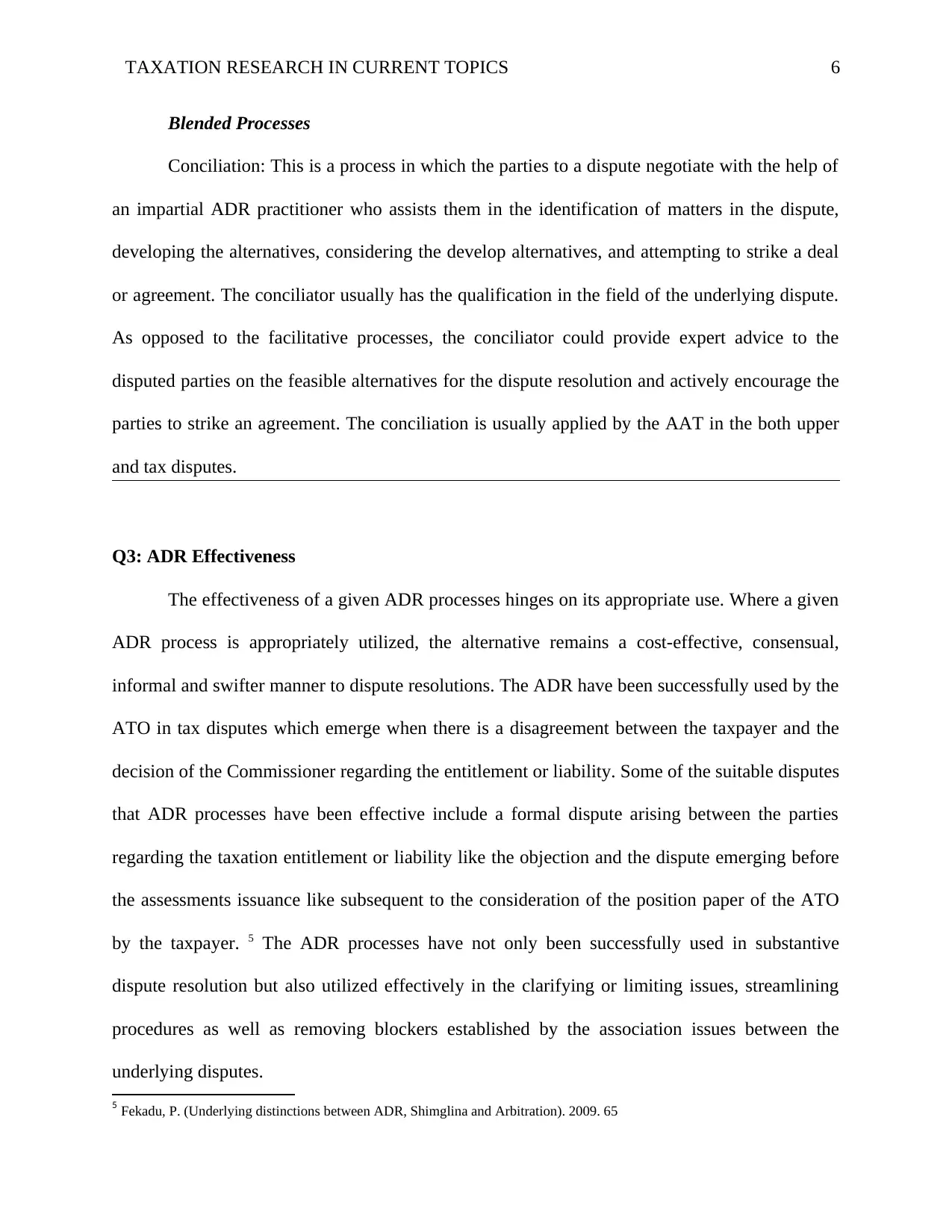
TAXATION RESEARCH IN CURRENT TOPICS 6
Blended Processes
Conciliation: This is a process in which the parties to a dispute negotiate with the help of
an impartial ADR practitioner who assists them in the identification of matters in the dispute,
developing the alternatives, considering the develop alternatives, and attempting to strike a deal
or agreement. The conciliator usually has the qualification in the field of the underlying dispute.
As opposed to the facilitative processes, the conciliator could provide expert advice to the
disputed parties on the feasible alternatives for the dispute resolution and actively encourage the
parties to strike an agreement. The conciliation is usually applied by the AAT in the both upper
and tax disputes.
Q3: ADR Effectiveness
The effectiveness of a given ADR processes hinges on its appropriate use. Where a given
ADR process is appropriately utilized, the alternative remains a cost-effective, consensual,
informal and swifter manner to dispute resolutions. The ADR have been successfully used by the
ATO in tax disputes which emerge when there is a disagreement between the taxpayer and the
decision of the Commissioner regarding the entitlement or liability. Some of the suitable disputes
that ADR processes have been effective include a formal dispute arising between the parties
regarding the taxation entitlement or liability like the objection and the dispute emerging before
the assessments issuance like subsequent to the consideration of the position paper of the ATO
by the taxpayer. 5 The ADR processes have not only been successfully used in substantive
dispute resolution but also utilized effectively in the clarifying or limiting issues, streamlining
procedures as well as removing blockers established by the association issues between the
underlying disputes.
5 Fekadu, P. (Underlying distinctions between ADR, Shimglina and Arbitration). 2009. 65
Blended Processes
Conciliation: This is a process in which the parties to a dispute negotiate with the help of
an impartial ADR practitioner who assists them in the identification of matters in the dispute,
developing the alternatives, considering the develop alternatives, and attempting to strike a deal
or agreement. The conciliator usually has the qualification in the field of the underlying dispute.
As opposed to the facilitative processes, the conciliator could provide expert advice to the
disputed parties on the feasible alternatives for the dispute resolution and actively encourage the
parties to strike an agreement. The conciliation is usually applied by the AAT in the both upper
and tax disputes.
Q3: ADR Effectiveness
The effectiveness of a given ADR processes hinges on its appropriate use. Where a given
ADR process is appropriately utilized, the alternative remains a cost-effective, consensual,
informal and swifter manner to dispute resolutions. The ADR have been successfully used by the
ATO in tax disputes which emerge when there is a disagreement between the taxpayer and the
decision of the Commissioner regarding the entitlement or liability. Some of the suitable disputes
that ADR processes have been effective include a formal dispute arising between the parties
regarding the taxation entitlement or liability like the objection and the dispute emerging before
the assessments issuance like subsequent to the consideration of the position paper of the ATO
by the taxpayer. 5 The ADR processes have not only been successfully used in substantive
dispute resolution but also utilized effectively in the clarifying or limiting issues, streamlining
procedures as well as removing blockers established by the association issues between the
underlying disputes.
5 Fekadu, P. (Underlying distinctions between ADR, Shimglina and Arbitration). 2009. 65
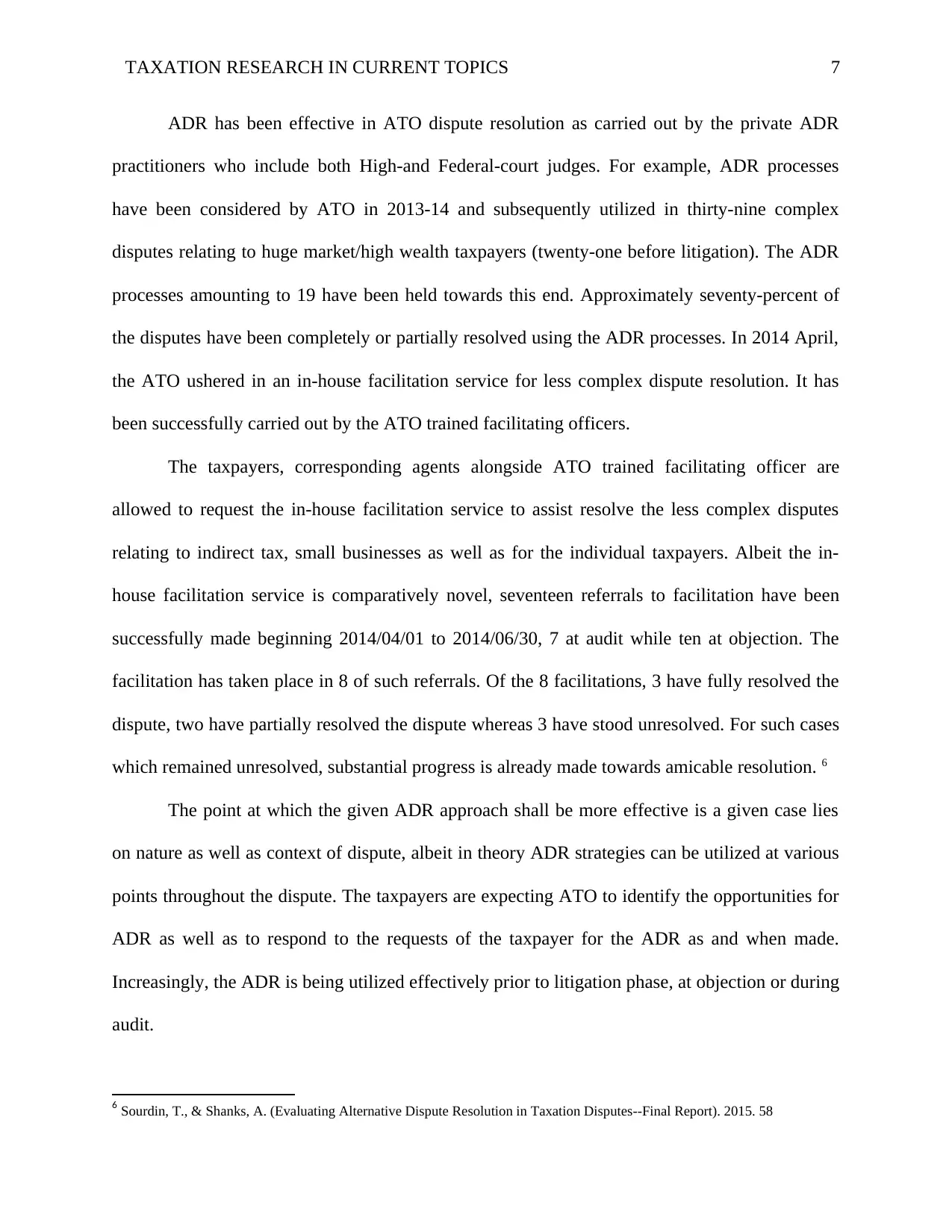
TAXATION RESEARCH IN CURRENT TOPICS 7
ADR has been effective in ATO dispute resolution as carried out by the private ADR
practitioners who include both High-and Federal-court judges. For example, ADR processes
have been considered by ATO in 2013-14 and subsequently utilized in thirty-nine complex
disputes relating to huge market/high wealth taxpayers (twenty-one before litigation). The ADR
processes amounting to 19 have been held towards this end. Approximately seventy-percent of
the disputes have been completely or partially resolved using the ADR processes. In 2014 April,
the ATO ushered in an in-house facilitation service for less complex dispute resolution. It has
been successfully carried out by the ATO trained facilitating officers.
The taxpayers, corresponding agents alongside ATO trained facilitating officer are
allowed to request the in-house facilitation service to assist resolve the less complex disputes
relating to indirect tax, small businesses as well as for the individual taxpayers. Albeit the in-
house facilitation service is comparatively novel, seventeen referrals to facilitation have been
successfully made beginning 2014/04/01 to 2014/06/30, 7 at audit while ten at objection. The
facilitation has taken place in 8 of such referrals. Of the 8 facilitations, 3 have fully resolved the
dispute, two have partially resolved the dispute whereas 3 have stood unresolved. For such cases
which remained unresolved, substantial progress is already made towards amicable resolution. 6
The point at which the given ADR approach shall be more effective is a given case lies
on nature as well as context of dispute, albeit in theory ADR strategies can be utilized at various
points throughout the dispute. The taxpayers are expecting ATO to identify the opportunities for
ADR as well as to respond to the requests of the taxpayer for the ADR as and when made.
Increasingly, the ADR is being utilized effectively prior to litigation phase, at objection or during
audit.
6 Sourdin, T., & Shanks, A. (Evaluating Alternative Dispute Resolution in Taxation Disputes--Final Report). 2015. 58
ADR has been effective in ATO dispute resolution as carried out by the private ADR
practitioners who include both High-and Federal-court judges. For example, ADR processes
have been considered by ATO in 2013-14 and subsequently utilized in thirty-nine complex
disputes relating to huge market/high wealth taxpayers (twenty-one before litigation). The ADR
processes amounting to 19 have been held towards this end. Approximately seventy-percent of
the disputes have been completely or partially resolved using the ADR processes. In 2014 April,
the ATO ushered in an in-house facilitation service for less complex dispute resolution. It has
been successfully carried out by the ATO trained facilitating officers.
The taxpayers, corresponding agents alongside ATO trained facilitating officer are
allowed to request the in-house facilitation service to assist resolve the less complex disputes
relating to indirect tax, small businesses as well as for the individual taxpayers. Albeit the in-
house facilitation service is comparatively novel, seventeen referrals to facilitation have been
successfully made beginning 2014/04/01 to 2014/06/30, 7 at audit while ten at objection. The
facilitation has taken place in 8 of such referrals. Of the 8 facilitations, 3 have fully resolved the
dispute, two have partially resolved the dispute whereas 3 have stood unresolved. For such cases
which remained unresolved, substantial progress is already made towards amicable resolution. 6
The point at which the given ADR approach shall be more effective is a given case lies
on nature as well as context of dispute, albeit in theory ADR strategies can be utilized at various
points throughout the dispute. The taxpayers are expecting ATO to identify the opportunities for
ADR as well as to respond to the requests of the taxpayer for the ADR as and when made.
Increasingly, the ADR is being utilized effectively prior to litigation phase, at objection or during
audit.
6 Sourdin, T., & Shanks, A. (Evaluating Alternative Dispute Resolution in Taxation Disputes--Final Report). 2015. 58
Paraphrase This Document
Need a fresh take? Get an instant paraphrase of this document with our AI Paraphraser
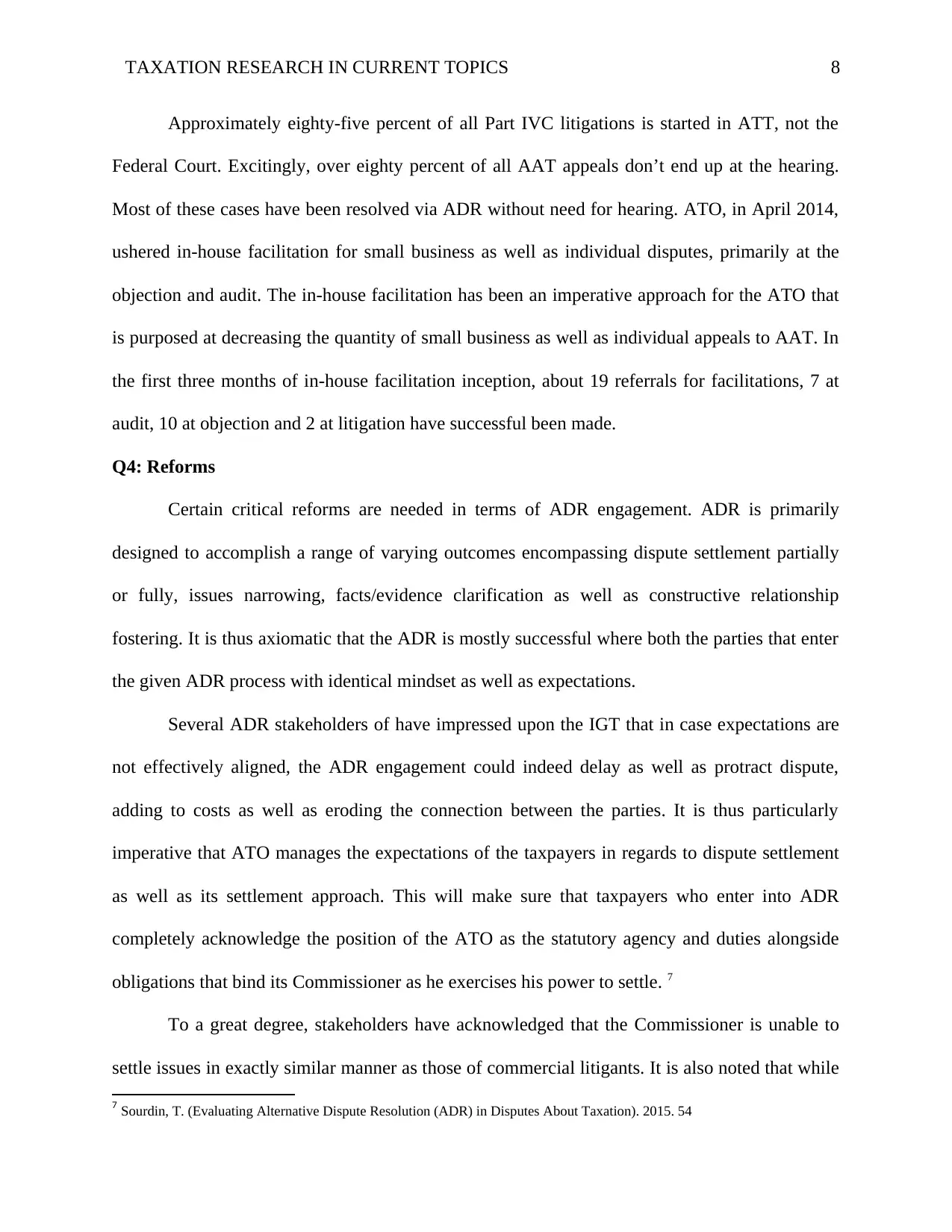
TAXATION RESEARCH IN CURRENT TOPICS 8
Approximately eighty-five percent of all Part IVC litigations is started in ATT, not the
Federal Court. Excitingly, over eighty percent of all AAT appeals don’t end up at the hearing.
Most of these cases have been resolved via ADR without need for hearing. ATO, in April 2014,
ushered in-house facilitation for small business as well as individual disputes, primarily at the
objection and audit. The in-house facilitation has been an imperative approach for the ATO that
is purposed at decreasing the quantity of small business as well as individual appeals to AAT. In
the first three months of in-house facilitation inception, about 19 referrals for facilitations, 7 at
audit, 10 at objection and 2 at litigation have successful been made.
Q4: Reforms
Certain critical reforms are needed in terms of ADR engagement. ADR is primarily
designed to accomplish a range of varying outcomes encompassing dispute settlement partially
or fully, issues narrowing, facts/evidence clarification as well as constructive relationship
fostering. It is thus axiomatic that the ADR is mostly successful where both the parties that enter
the given ADR process with identical mindset as well as expectations.
Several ADR stakeholders of have impressed upon the IGT that in case expectations are
not effectively aligned, the ADR engagement could indeed delay as well as protract dispute,
adding to costs as well as eroding the connection between the parties. It is thus particularly
imperative that ATO manages the expectations of the taxpayers in regards to dispute settlement
as well as its settlement approach. This will make sure that taxpayers who enter into ADR
completely acknowledge the position of the ATO as the statutory agency and duties alongside
obligations that bind its Commissioner as he exercises his power to settle. 7
To a great degree, stakeholders have acknowledged that the Commissioner is unable to
settle issues in exactly similar manner as those of commercial litigants. It is also noted that while
7 Sourdin, T. (Evaluating Alternative Dispute Resolution (ADR) in Disputes About Taxation). 2015. 54
Approximately eighty-five percent of all Part IVC litigations is started in ATT, not the
Federal Court. Excitingly, over eighty percent of all AAT appeals don’t end up at the hearing.
Most of these cases have been resolved via ADR without need for hearing. ATO, in April 2014,
ushered in-house facilitation for small business as well as individual disputes, primarily at the
objection and audit. The in-house facilitation has been an imperative approach for the ATO that
is purposed at decreasing the quantity of small business as well as individual appeals to AAT. In
the first three months of in-house facilitation inception, about 19 referrals for facilitations, 7 at
audit, 10 at objection and 2 at litigation have successful been made.
Q4: Reforms
Certain critical reforms are needed in terms of ADR engagement. ADR is primarily
designed to accomplish a range of varying outcomes encompassing dispute settlement partially
or fully, issues narrowing, facts/evidence clarification as well as constructive relationship
fostering. It is thus axiomatic that the ADR is mostly successful where both the parties that enter
the given ADR process with identical mindset as well as expectations.
Several ADR stakeholders of have impressed upon the IGT that in case expectations are
not effectively aligned, the ADR engagement could indeed delay as well as protract dispute,
adding to costs as well as eroding the connection between the parties. It is thus particularly
imperative that ATO manages the expectations of the taxpayers in regards to dispute settlement
as well as its settlement approach. This will make sure that taxpayers who enter into ADR
completely acknowledge the position of the ATO as the statutory agency and duties alongside
obligations that bind its Commissioner as he exercises his power to settle. 7
To a great degree, stakeholders have acknowledged that the Commissioner is unable to
settle issues in exactly similar manner as those of commercial litigants. It is also noted that while
7 Sourdin, T. (Evaluating Alternative Dispute Resolution (ADR) in Disputes About Taxation). 2015. 54
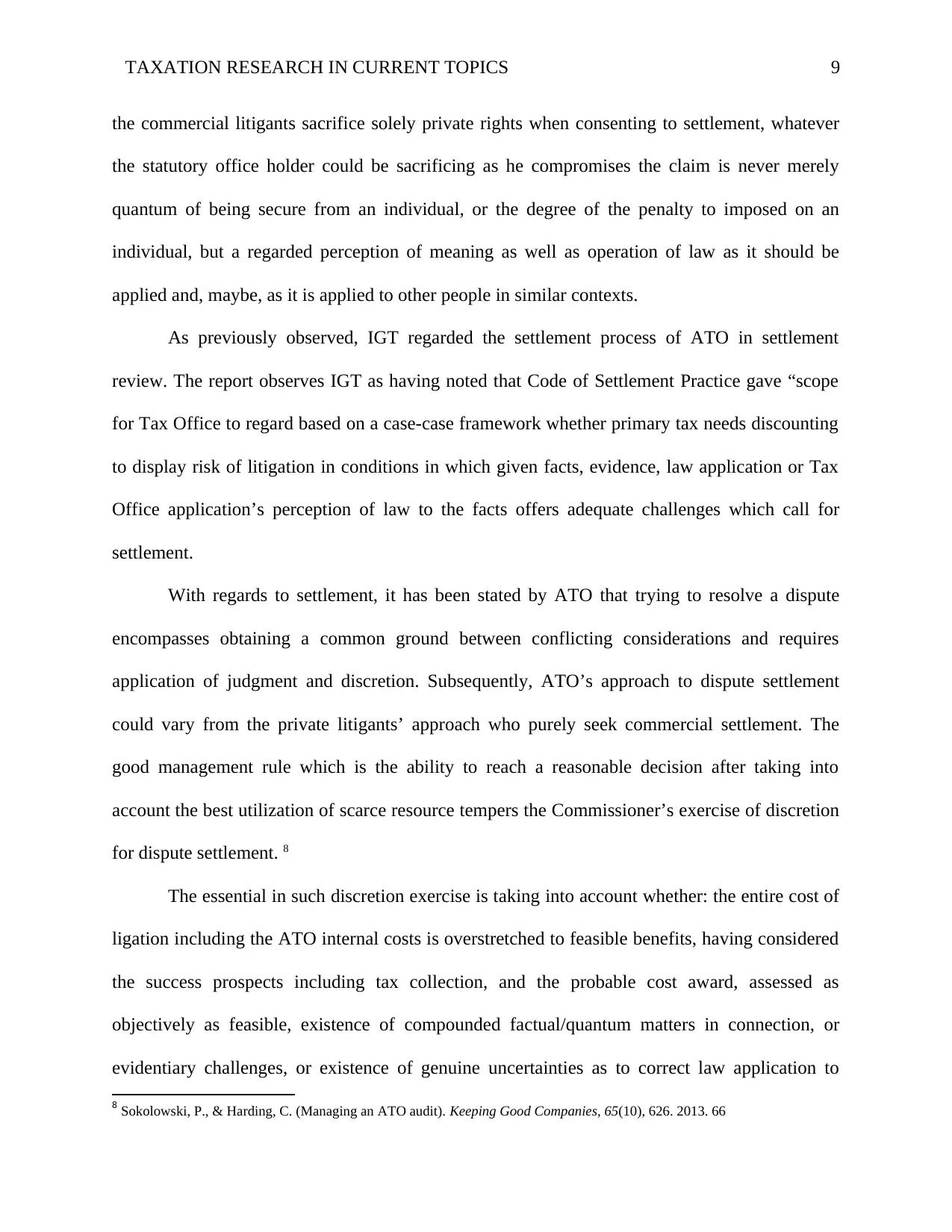
TAXATION RESEARCH IN CURRENT TOPICS 9
the commercial litigants sacrifice solely private rights when consenting to settlement, whatever
the statutory office holder could be sacrificing as he compromises the claim is never merely
quantum of being secure from an individual, or the degree of the penalty to imposed on an
individual, but a regarded perception of meaning as well as operation of law as it should be
applied and, maybe, as it is applied to other people in similar contexts.
As previously observed, IGT regarded the settlement process of ATO in settlement
review. The report observes IGT as having noted that Code of Settlement Practice gave “scope
for Tax Office to regard based on a case-case framework whether primary tax needs discounting
to display risk of litigation in conditions in which given facts, evidence, law application or Tax
Office application’s perception of law to the facts offers adequate challenges which call for
settlement.
With regards to settlement, it has been stated by ATO that trying to resolve a dispute
encompasses obtaining a common ground between conflicting considerations and requires
application of judgment and discretion. Subsequently, ATO’s approach to dispute settlement
could vary from the private litigants’ approach who purely seek commercial settlement. The
good management rule which is the ability to reach a reasonable decision after taking into
account the best utilization of scarce resource tempers the Commissioner’s exercise of discretion
for dispute settlement. 8
The essential in such discretion exercise is taking into account whether: the entire cost of
ligation including the ATO internal costs is overstretched to feasible benefits, having considered
the success prospects including tax collection, and the probable cost award, assessed as
objectively as feasible, existence of compounded factual/quantum matters in connection, or
evidentiary challenges, or existence of genuine uncertainties as to correct law application to
8 Sokolowski, P., & Harding, C. (Managing an ATO audit). Keeping Good Companies, 65(10), 626. 2013. 66
the commercial litigants sacrifice solely private rights when consenting to settlement, whatever
the statutory office holder could be sacrificing as he compromises the claim is never merely
quantum of being secure from an individual, or the degree of the penalty to imposed on an
individual, but a regarded perception of meaning as well as operation of law as it should be
applied and, maybe, as it is applied to other people in similar contexts.
As previously observed, IGT regarded the settlement process of ATO in settlement
review. The report observes IGT as having noted that Code of Settlement Practice gave “scope
for Tax Office to regard based on a case-case framework whether primary tax needs discounting
to display risk of litigation in conditions in which given facts, evidence, law application or Tax
Office application’s perception of law to the facts offers adequate challenges which call for
settlement.
With regards to settlement, it has been stated by ATO that trying to resolve a dispute
encompasses obtaining a common ground between conflicting considerations and requires
application of judgment and discretion. Subsequently, ATO’s approach to dispute settlement
could vary from the private litigants’ approach who purely seek commercial settlement. The
good management rule which is the ability to reach a reasonable decision after taking into
account the best utilization of scarce resource tempers the Commissioner’s exercise of discretion
for dispute settlement. 8
The essential in such discretion exercise is taking into account whether: the entire cost of
ligation including the ATO internal costs is overstretched to feasible benefits, having considered
the success prospects including tax collection, and the probable cost award, assessed as
objectively as feasible, existence of compounded factual/quantum matters in connection, or
evidentiary challenges, or existence of genuine uncertainties as to correct law application to
8 Sokolowski, P., & Harding, C. (Managing an ATO audit). Keeping Good Companies, 65(10), 626. 2013. 66
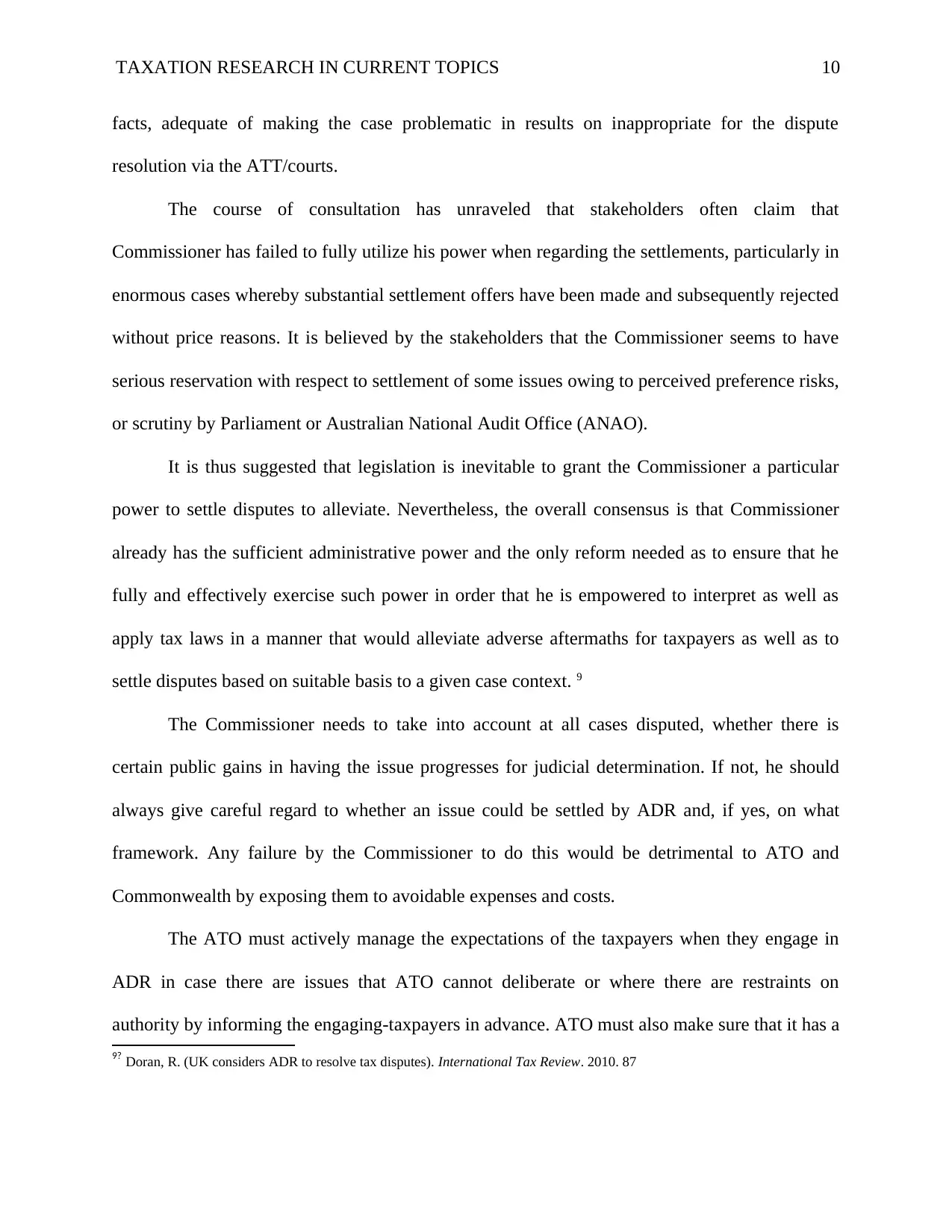
TAXATION RESEARCH IN CURRENT TOPICS 10
facts, adequate of making the case problematic in results on inappropriate for the dispute
resolution via the ATT/courts.
The course of consultation has unraveled that stakeholders often claim that
Commissioner has failed to fully utilize his power when regarding the settlements, particularly in
enormous cases whereby substantial settlement offers have been made and subsequently rejected
without price reasons. It is believed by the stakeholders that the Commissioner seems to have
serious reservation with respect to settlement of some issues owing to perceived preference risks,
or scrutiny by Parliament or Australian National Audit Office (ANAO).
It is thus suggested that legislation is inevitable to grant the Commissioner a particular
power to settle disputes to alleviate. Nevertheless, the overall consensus is that Commissioner
already has the sufficient administrative power and the only reform needed as to ensure that he
fully and effectively exercise such power in order that he is empowered to interpret as well as
apply tax laws in a manner that would alleviate adverse aftermaths for taxpayers as well as to
settle disputes based on suitable basis to a given case context. 9
The Commissioner needs to take into account at all cases disputed, whether there is
certain public gains in having the issue progresses for judicial determination. If not, he should
always give careful regard to whether an issue could be settled by ADR and, if yes, on what
framework. Any failure by the Commissioner to do this would be detrimental to ATO and
Commonwealth by exposing them to avoidable expenses and costs.
The ATO must actively manage the expectations of the taxpayers when they engage in
ADR in case there are issues that ATO cannot deliberate or where there are restraints on
authority by informing the engaging-taxpayers in advance. ATO must also make sure that it has a
9? Doran, R. (UK considers ADR to resolve tax disputes). International Tax Review. 2010. 87
facts, adequate of making the case problematic in results on inappropriate for the dispute
resolution via the ATT/courts.
The course of consultation has unraveled that stakeholders often claim that
Commissioner has failed to fully utilize his power when regarding the settlements, particularly in
enormous cases whereby substantial settlement offers have been made and subsequently rejected
without price reasons. It is believed by the stakeholders that the Commissioner seems to have
serious reservation with respect to settlement of some issues owing to perceived preference risks,
or scrutiny by Parliament or Australian National Audit Office (ANAO).
It is thus suggested that legislation is inevitable to grant the Commissioner a particular
power to settle disputes to alleviate. Nevertheless, the overall consensus is that Commissioner
already has the sufficient administrative power and the only reform needed as to ensure that he
fully and effectively exercise such power in order that he is empowered to interpret as well as
apply tax laws in a manner that would alleviate adverse aftermaths for taxpayers as well as to
settle disputes based on suitable basis to a given case context. 9
The Commissioner needs to take into account at all cases disputed, whether there is
certain public gains in having the issue progresses for judicial determination. If not, he should
always give careful regard to whether an issue could be settled by ADR and, if yes, on what
framework. Any failure by the Commissioner to do this would be detrimental to ATO and
Commonwealth by exposing them to avoidable expenses and costs.
The ATO must actively manage the expectations of the taxpayers when they engage in
ADR in case there are issues that ATO cannot deliberate or where there are restraints on
authority by informing the engaging-taxpayers in advance. ATO must also make sure that it has a
9? Doran, R. (UK considers ADR to resolve tax disputes). International Tax Review. 2010. 87
Secure Best Marks with AI Grader
Need help grading? Try our AI Grader for instant feedback on your assignments.
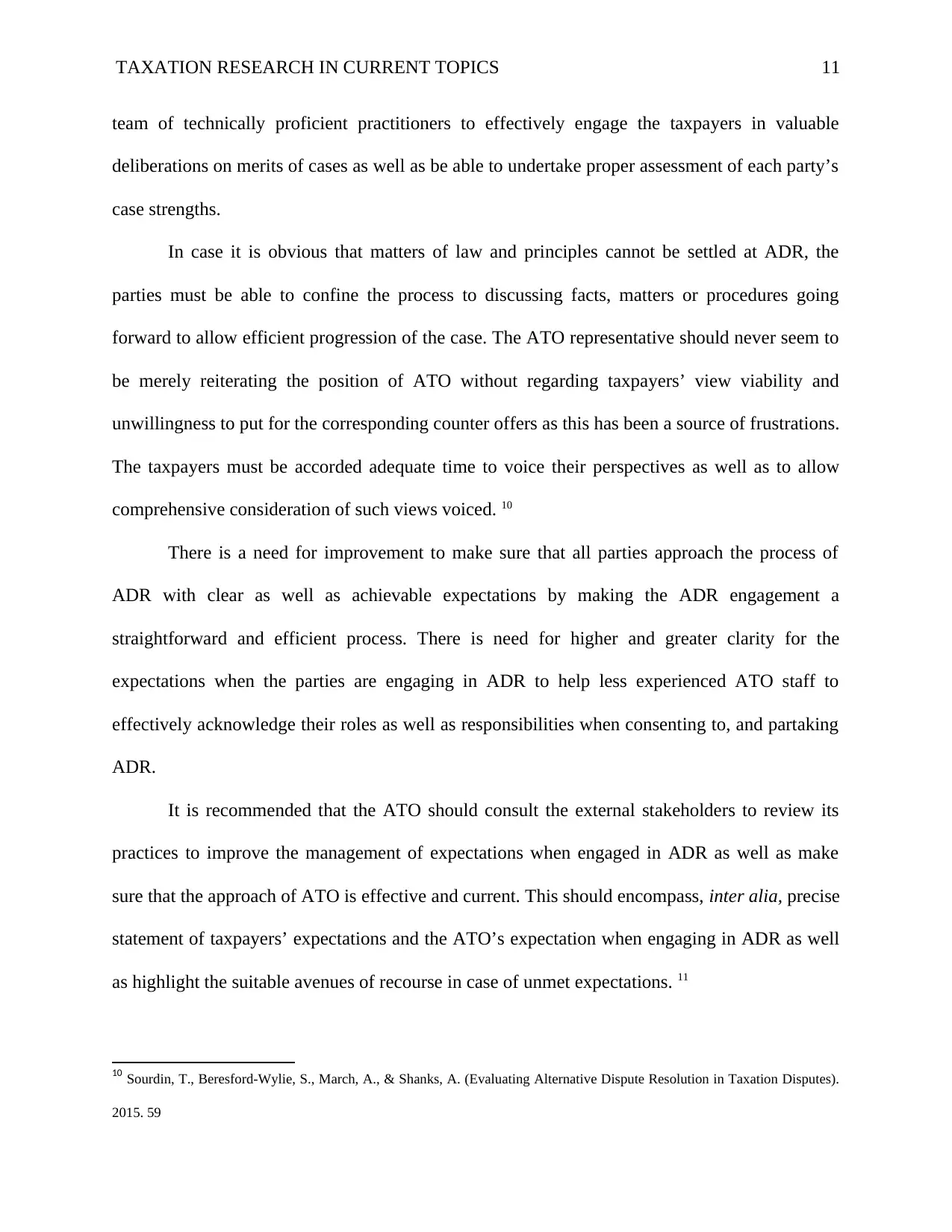
TAXATION RESEARCH IN CURRENT TOPICS 11
team of technically proficient practitioners to effectively engage the taxpayers in valuable
deliberations on merits of cases as well as be able to undertake proper assessment of each party’s
case strengths.
In case it is obvious that matters of law and principles cannot be settled at ADR, the
parties must be able to confine the process to discussing facts, matters or procedures going
forward to allow efficient progression of the case. The ATO representative should never seem to
be merely reiterating the position of ATO without regarding taxpayers’ view viability and
unwillingness to put for the corresponding counter offers as this has been a source of frustrations.
The taxpayers must be accorded adequate time to voice their perspectives as well as to allow
comprehensive consideration of such views voiced. 10
There is a need for improvement to make sure that all parties approach the process of
ADR with clear as well as achievable expectations by making the ADR engagement a
straightforward and efficient process. There is need for higher and greater clarity for the
expectations when the parties are engaging in ADR to help less experienced ATO staff to
effectively acknowledge their roles as well as responsibilities when consenting to, and partaking
ADR.
It is recommended that the ATO should consult the external stakeholders to review its
practices to improve the management of expectations when engaged in ADR as well as make
sure that the approach of ATO is effective and current. This should encompass, inter alia, precise
statement of taxpayers’ expectations and the ATO’s expectation when engaging in ADR as well
as highlight the suitable avenues of recourse in case of unmet expectations. 11
10 Sourdin, T., Beresford-Wylie, S., March, A., & Shanks, A. (Evaluating Alternative Dispute Resolution in Taxation Disputes).
2015. 59
team of technically proficient practitioners to effectively engage the taxpayers in valuable
deliberations on merits of cases as well as be able to undertake proper assessment of each party’s
case strengths.
In case it is obvious that matters of law and principles cannot be settled at ADR, the
parties must be able to confine the process to discussing facts, matters or procedures going
forward to allow efficient progression of the case. The ATO representative should never seem to
be merely reiterating the position of ATO without regarding taxpayers’ view viability and
unwillingness to put for the corresponding counter offers as this has been a source of frustrations.
The taxpayers must be accorded adequate time to voice their perspectives as well as to allow
comprehensive consideration of such views voiced. 10
There is a need for improvement to make sure that all parties approach the process of
ADR with clear as well as achievable expectations by making the ADR engagement a
straightforward and efficient process. There is need for higher and greater clarity for the
expectations when the parties are engaging in ADR to help less experienced ATO staff to
effectively acknowledge their roles as well as responsibilities when consenting to, and partaking
ADR.
It is recommended that the ATO should consult the external stakeholders to review its
practices to improve the management of expectations when engaged in ADR as well as make
sure that the approach of ATO is effective and current. This should encompass, inter alia, precise
statement of taxpayers’ expectations and the ATO’s expectation when engaging in ADR as well
as highlight the suitable avenues of recourse in case of unmet expectations. 11
10 Sourdin, T., Beresford-Wylie, S., March, A., & Shanks, A. (Evaluating Alternative Dispute Resolution in Taxation Disputes).
2015. 59
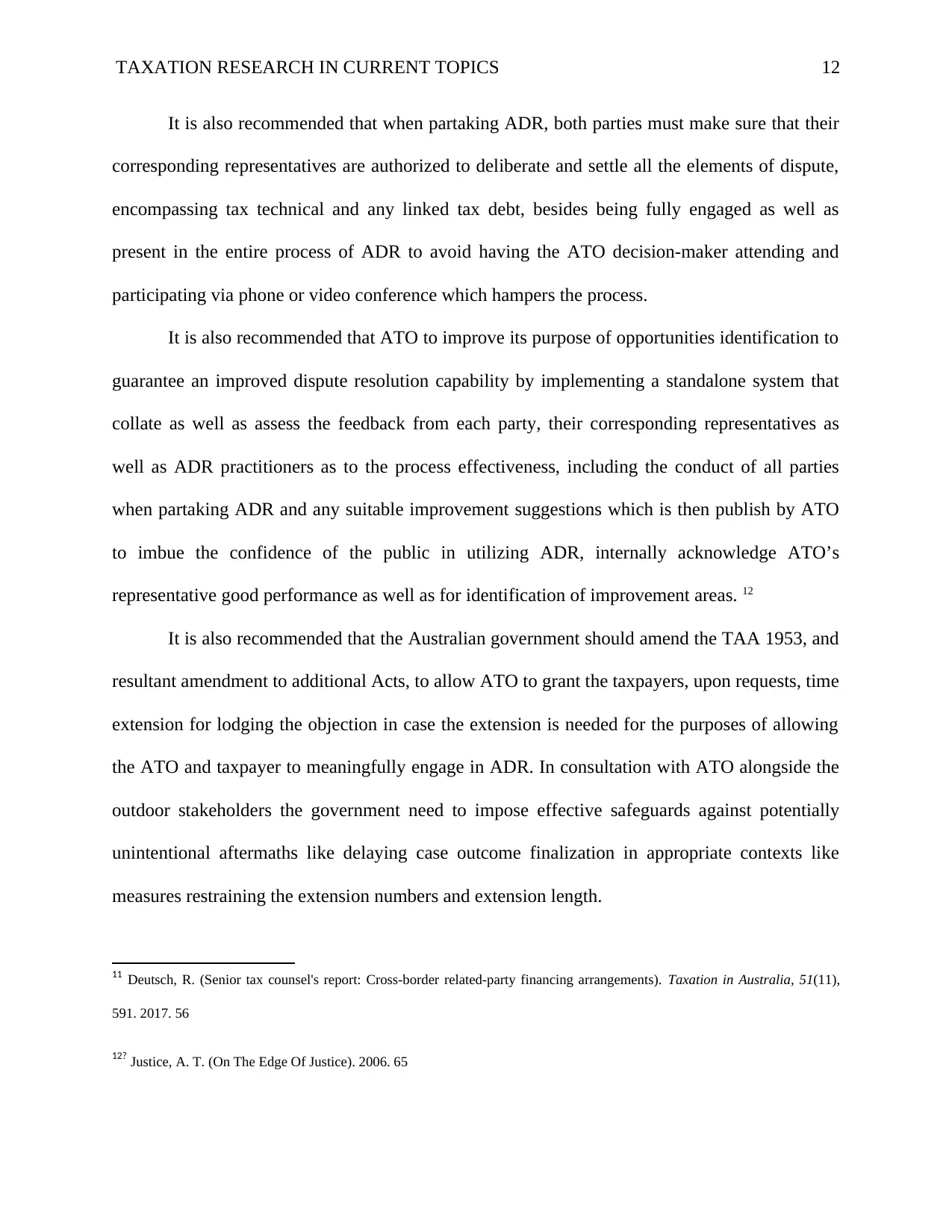
TAXATION RESEARCH IN CURRENT TOPICS 12
It is also recommended that when partaking ADR, both parties must make sure that their
corresponding representatives are authorized to deliberate and settle all the elements of dispute,
encompassing tax technical and any linked tax debt, besides being fully engaged as well as
present in the entire process of ADR to avoid having the ATO decision-maker attending and
participating via phone or video conference which hampers the process.
It is also recommended that ATO to improve its purpose of opportunities identification to
guarantee an improved dispute resolution capability by implementing a standalone system that
collate as well as assess the feedback from each party, their corresponding representatives as
well as ADR practitioners as to the process effectiveness, including the conduct of all parties
when partaking ADR and any suitable improvement suggestions which is then publish by ATO
to imbue the confidence of the public in utilizing ADR, internally acknowledge ATO’s
representative good performance as well as for identification of improvement areas. 12
It is also recommended that the Australian government should amend the TAA 1953, and
resultant amendment to additional Acts, to allow ATO to grant the taxpayers, upon requests, time
extension for lodging the objection in case the extension is needed for the purposes of allowing
the ATO and taxpayer to meaningfully engage in ADR. In consultation with ATO alongside the
outdoor stakeholders the government need to impose effective safeguards against potentially
unintentional aftermaths like delaying case outcome finalization in appropriate contexts like
measures restraining the extension numbers and extension length.
11 Deutsch, R. (Senior tax counsel's report: Cross-border related-party financing arrangements). Taxation in Australia, 51(11),
591. 2017. 56
12? Justice, A. T. (On The Edge Of Justice). 2006. 65
It is also recommended that when partaking ADR, both parties must make sure that their
corresponding representatives are authorized to deliberate and settle all the elements of dispute,
encompassing tax technical and any linked tax debt, besides being fully engaged as well as
present in the entire process of ADR to avoid having the ATO decision-maker attending and
participating via phone or video conference which hampers the process.
It is also recommended that ATO to improve its purpose of opportunities identification to
guarantee an improved dispute resolution capability by implementing a standalone system that
collate as well as assess the feedback from each party, their corresponding representatives as
well as ADR practitioners as to the process effectiveness, including the conduct of all parties
when partaking ADR and any suitable improvement suggestions which is then publish by ATO
to imbue the confidence of the public in utilizing ADR, internally acknowledge ATO’s
representative good performance as well as for identification of improvement areas. 12
It is also recommended that the Australian government should amend the TAA 1953, and
resultant amendment to additional Acts, to allow ATO to grant the taxpayers, upon requests, time
extension for lodging the objection in case the extension is needed for the purposes of allowing
the ATO and taxpayer to meaningfully engage in ADR. In consultation with ATO alongside the
outdoor stakeholders the government need to impose effective safeguards against potentially
unintentional aftermaths like delaying case outcome finalization in appropriate contexts like
measures restraining the extension numbers and extension length.
11 Deutsch, R. (Senior tax counsel's report: Cross-border related-party financing arrangements). Taxation in Australia, 51(11),
591. 2017. 56
12? Justice, A. T. (On The Edge Of Justice). 2006. 65
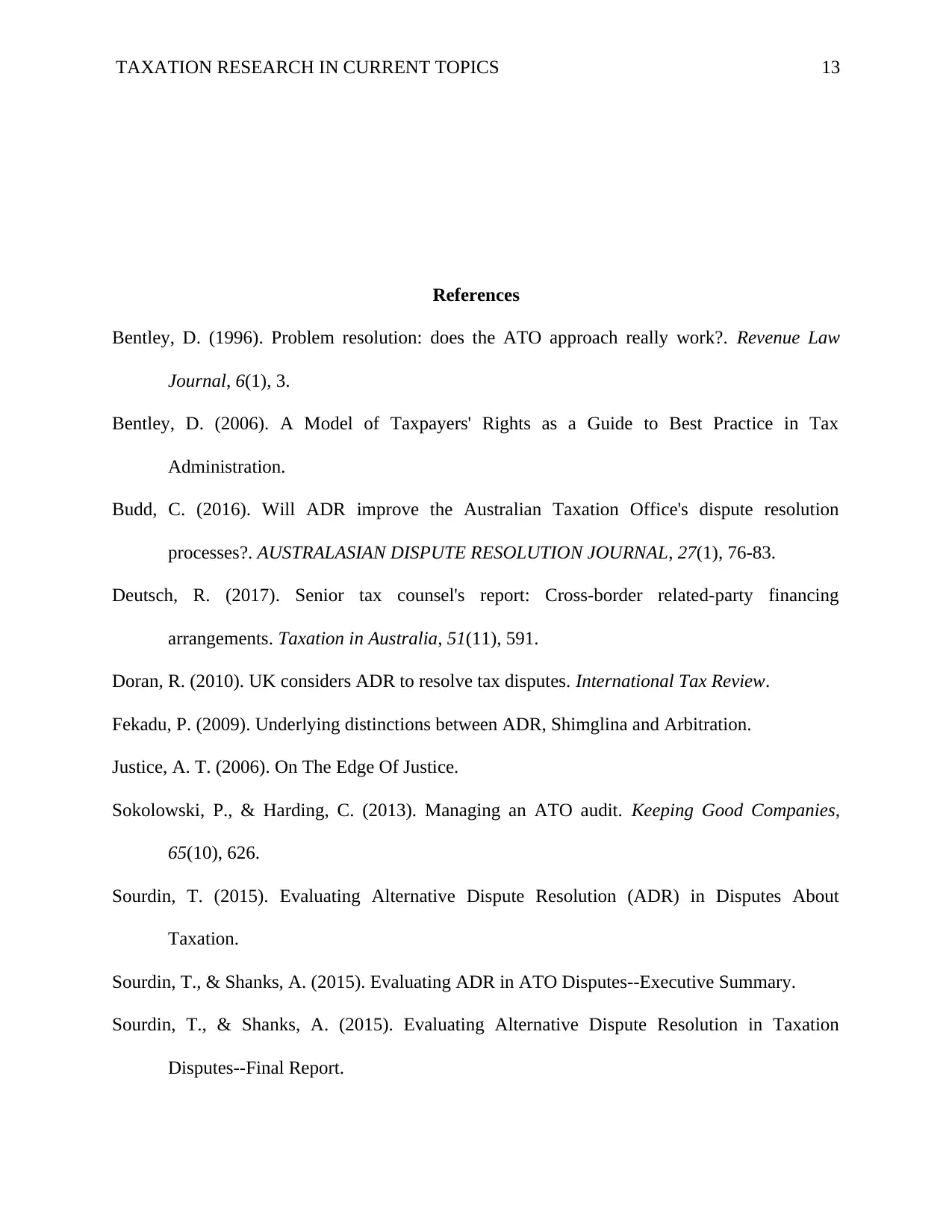
TAXATION RESEARCH IN CURRENT TOPICS 13
References
Bentley, D. (1996). Problem resolution: does the ATO approach really work?. Revenue Law
Journal, 6(1), 3.
Bentley, D. (2006). A Model of Taxpayers' Rights as a Guide to Best Practice in Tax
Administration.
Budd, C. (2016). Will ADR improve the Australian Taxation Office's dispute resolution
processes?. AUSTRALASIAN DISPUTE RESOLUTION JOURNAL, 27(1), 76-83.
Deutsch, R. (2017). Senior tax counsel's report: Cross-border related-party financing
arrangements. Taxation in Australia, 51(11), 591.
Doran, R. (2010). UK considers ADR to resolve tax disputes. International Tax Review.
Fekadu, P. (2009). Underlying distinctions between ADR, Shimglina and Arbitration.
Justice, A. T. (2006). On The Edge Of Justice.
Sokolowski, P., & Harding, C. (2013). Managing an ATO audit. Keeping Good Companies,
65(10), 626.
Sourdin, T. (2015). Evaluating Alternative Dispute Resolution (ADR) in Disputes About
Taxation.
Sourdin, T., & Shanks, A. (2015). Evaluating ADR in ATO Disputes--Executive Summary.
Sourdin, T., & Shanks, A. (2015). Evaluating Alternative Dispute Resolution in Taxation
Disputes--Final Report.
References
Bentley, D. (1996). Problem resolution: does the ATO approach really work?. Revenue Law
Journal, 6(1), 3.
Bentley, D. (2006). A Model of Taxpayers' Rights as a Guide to Best Practice in Tax
Administration.
Budd, C. (2016). Will ADR improve the Australian Taxation Office's dispute resolution
processes?. AUSTRALASIAN DISPUTE RESOLUTION JOURNAL, 27(1), 76-83.
Deutsch, R. (2017). Senior tax counsel's report: Cross-border related-party financing
arrangements. Taxation in Australia, 51(11), 591.
Doran, R. (2010). UK considers ADR to resolve tax disputes. International Tax Review.
Fekadu, P. (2009). Underlying distinctions between ADR, Shimglina and Arbitration.
Justice, A. T. (2006). On The Edge Of Justice.
Sokolowski, P., & Harding, C. (2013). Managing an ATO audit. Keeping Good Companies,
65(10), 626.
Sourdin, T. (2015). Evaluating Alternative Dispute Resolution (ADR) in Disputes About
Taxation.
Sourdin, T., & Shanks, A. (2015). Evaluating ADR in ATO Disputes--Executive Summary.
Sourdin, T., & Shanks, A. (2015). Evaluating Alternative Dispute Resolution in Taxation
Disputes--Final Report.
Paraphrase This Document
Need a fresh take? Get an instant paraphrase of this document with our AI Paraphraser

TAXATION RESEARCH IN CURRENT TOPICS 14
Sourdin, T., Beresford-Wylie, S., March, A., & Shanks, A. (2015). Evaluating Alternative
Dispute Resolution in Taxation Disputes.
Sourdin, T., Beresford-Wylie, S., March, A., & Shanks, A. (2015). Evaluating Alternative
Dispute Resolution in Taxation Disputes.
1 out of 14
Your All-in-One AI-Powered Toolkit for Academic Success.
+13062052269
info@desklib.com
Available 24*7 on WhatsApp / Email
![[object Object]](/_next/static/media/star-bottom.7253800d.svg)
Unlock your academic potential
© 2024 | Zucol Services PVT LTD | All rights reserved.

